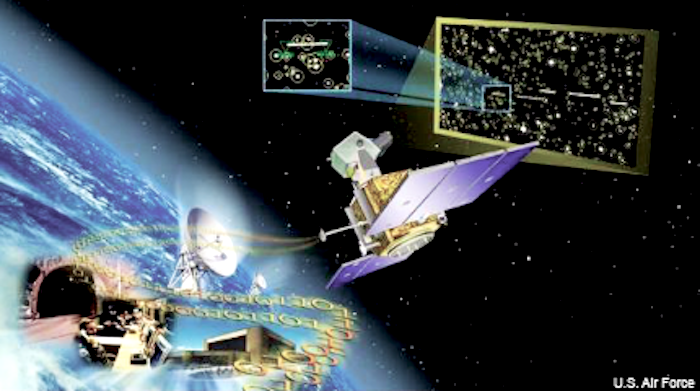.

Air Force Space Based Space Surveillance Satellites operate in low Earth orbit.
A debate is raging among U.S. policy wonks over how best to prevent a "space Pearl Harbor."
Those concerns have grown in recent years with light-saber-rattling between the U.S. and China over a debris-generating Chinese anti-satellite (ASAT) test in 2007, along with growing tensions between Moscow and Washington. Some even worry that increased "counterspace testing" in the form of kinetic ASAT tests, jamming and the use of lasers to blind satellite optics could eventually leave low Earth orbit unusable.
The U.S. National Security Space Strategy highlights the fact that "space is increasingly congested. Growing global space activity and testing of China’s destructive anti-satellite system have increased congestion in important areas in space. "
The debate over space deterrence is playing out in space policy journals in which analysts have argued back and forth over whether the current U.S military space strategy requires an overhaul. Meanwhile, experts are fearful that U.S. space assets like military communications satellites are especially vulnerable to asymmetric warfare. Indeed, the U.S. military is far more reliant on space systems than Russia or China, a reality some policy makers assert China is attempting to exploit.
As U.S. counterspace strategy evolves, experts are debating whether traditional space deterrence should evolve along with growing threats. Proposed revisions to the U.S military space strategy have argued for a layered approach to deterring space attacks. Recommendations submitted to the Defense Department in 2014 by the Eisenhower Center for Space and Defense Studies outlined a series of escalating steps aimed at blunting asymmetric attacks on U.S. space assets.
The proposed layered defenses include: diplomacy and enforcement of international norms; military and commercial alliances; resilience, or demonstrating the ability to withstand a space attack; and, finally, retaliation.
Retaliation would include a "demonstrated ability of the United States to deliver unacceptable damage even if confronted with a broad spectrum of attacks against its space assets as well as those available to its allies and the commercial sector," Ambassador Roger G. Harrison and retired Lt. Col. Deron Jackson of the Eisenhower Center wrote in the journal The Space Review. Harrison and Jackson, respectively the former and current directors of the Eisenhower Center, were responding to criticism of the think tank's space deterrence proposals.
Christopher Stone, a space policy analyst, argued that the layered defense approach leaves U.S. space assets vulnerable in an asymmetric conflict. China followed its 2007 test with additional kinetic ASAT tests along with "lasing of satellites and an apparent new norm of nation-state behavior in space via the tripling of reversible counterspace attacks such as jamming and other means of interference," Stone asserted.
In response, Harrison and Jackson acknowledged: "An enemy that can put the United States off balance through an attack on space systems, but is not equally dependent on space systems to coordinate its own military operations, will be on its way to victory while American strategists are looking to assess the effects of retaliation against the enemy’s space assets."
Stone argues that military planners must design "future architectures and strategies for space security so that we are better able to tailor our deterrence strategy to the adversaries we might face, and are already facing…."
To some extent, the Air Force has begun doing just that with the planned launched of maneuverable communications satellites and increased testing of laser weapons that could be used as part of an overall counterspace strategy.
Quelle: Defense Systems
4200 Views
